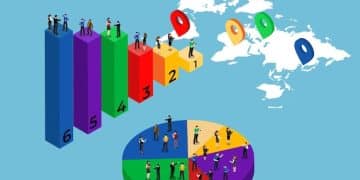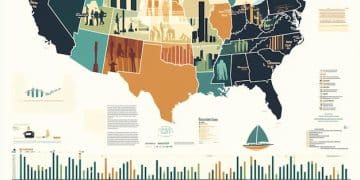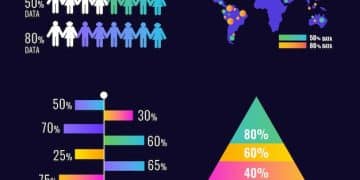2025 US Census: 5 Key Demographic Shifts & Policy Impact

The 2025 US Census Data: 5 Key Demographic Shifts Impacting National Policy reveals profound changes in the American population, directly influencing future policy decisions in areas like healthcare, education, and infrastructure. Understanding these shifts is crucial for effective governance and resource allocation across the nation.
The United States stands on the cusp of significant demographic transformation, a story told vividly through the forthcoming 2025 US Census Data: 5 Key Demographic Shifts Impacting National Policy. This crucial dataset promises to offer an unparalleled snapshot of America, providing insights indispensable for policymakers, businesses, and communities alike. As we peer into the near future, certain trends are becoming increasingly apparent, signaling a shift in the very fabric of American society. These evolving patterns will undoubtedly reshape national priorities, from resource distribution to legislative agendas, demanding a proactive and informed response.
The Aging of America: A Growing Silver Tsunami
One of the most profound demographic changes highlighted by the impending 2025 Census data is the accelerating aging of the American population. This isn’t merely a slight increase in average age; it represents a fundamental restructuring of generational cohorts, with significant implications for social welfare programs, healthcare systems, and the labor market.
Understanding the Dynamics of an Older Population
The cohort of individuals aged 65 and older is expanding at an unprecedented rate, largely due to increased life expectancy and declining birth rates in previous decades. This demographic shift, often dubbed the “Silver Tsunami,” necessitates a re-evaluation of existing frameworks.
- The Baby Boomer generation continues to transition into retirement, placing increased demands on Social Security and Medicare.
- Advances in medicine and public health mean people are living longer, often with complex chronic conditions requiring sustained care.
- Family structures are evolving, with fewer younger caregivers available to support elderly relatives, impacting long-term care models.
The implications extend beyond the immediate financial strain on entitlement programs. An older population often correlates with different consumption patterns, political priorities, and community needs. Housing, transportation, and urban planning must adapt to support a population with varying mobility and accessibility requirements.
Policy Responses to an Aging Society
Addressing the challenges posed by an aging America requires multi-faceted policy interventions. Discussions around Social Security reform, Medicare solvency, and the development of robust long-term care solutions are no longer theoretical but urgent necessities. These discussions must encompass not just funding mechanisms, but also innovative models of care delivery and support for family caregivers.
Furthermore, policies promoting active aging, encouraging continued labor force participation for older adults, and fostering intergenerational solidarity can help mitigate some of the negative consequences and harness the experience of an older demographic. The goal is to move beyond simply managing decline and instead focus on creating an inclusive society where older adults can thrive and contribute meaningfully.
The rising median age of the US population as revealed by the 2025 Census data will act as a critical bellwether, urging policy adjustments to ensure economic stability and social equity for all generations.

Shifting Racial and Ethnic Landscapes: A More Diverse Nation
The racial and ethnic composition of the United States is undergoing a profound transformation, a process that the 2025 Census data will undoubtedly underscore with new clarity. America is becoming an increasingly diverse nation, moving away from its historical black-white binary to a complex tapestry of cultures, languages, and identities. This shift carries significant implications for social cohesion, political representation, and economic opportunity.
The Rise of Multiracial and Hispanic/Latino Populations
Key drivers of this increased diversity include sustained immigration, higher birth rates among specific ethnic groups, and a growing number of individuals identifying with multiple racial backgrounds. The Hispanic/Latino population, for instance, continues to be a major growth engine, reshaping communities and cultural norms across the country. Simultaneously, the number of Americans identifying as multiracial is on a significant upward trend, reflecting a more fluid understanding of identity.
This demographic evolution impacts areas from education—where schools must adapt to diverse linguistic and cultural needs—to healthcare, where culturally competent care becomes paramount. Understanding these nuances is vital for developing effective public services that resonate with all segments of the population.
Policy Implications for a Diverse America
The political landscape is directly influenced by these shifting demographics. Changes in voting blocs and increased demand for equitable representation mean policymakers must engage with a broader array of community voices. Policies related to immigration, civil rights, and affirmative action will continue to be central to national discourse, viewed through the lens of an evolving demographic reality.
- Addressing systemic inequalities in areas like housing, employment, and justice is crucial to foster equitable outcomes for all groups.
- Investing in language access programs and culturally sensitive public services can enhance civic participation and social integration.
- Promoting diversity and inclusion in leadership positions across all sectors better reflects the nation’s makeup and brings varied perspectives to decision-making.
Furthermore, the economic impact of a diverse workforce is substantial. Different cultural backgrounds often bring unique perspectives and skills, fostering innovation and competitiveness. Policies that support integration and address discriminatory practices are essential to fully harness this potential. The 2025 Census data will provide the definitive evidence of how far this transformation has progressed, challenging the nation to adapt and embrace its increasingly pluralistic future.
Urbanization and Rural Exodus: Concentrating Populations
The movement of people within the United States, particularly the ongoing trend of urbanization and the simultaneous rural exodus, remains a pivotal demographic shift that the 2025 Census will likely emphasize. This geographical redistribution of the population has profound consequences for infrastructure, economic development, and environmental planning in both urban and rural areas.
Drivers of Urban Growth and Rural Decline
Urban centers continue to attract residents with promises of economic opportunity, diverse job markets, and access to a wider array of services and amenities. Younger generations and immigrant communities often gravitate towards cities, contributing to their vibrancy and growth. Conversely, many rural areas face challenges such as declining industries, lack of investment, and limited access to essential services like healthcare and broadband internet, leading to out-migration.
This dynamic creates a two-tiered system: burgeoning cities grapple with issues like affordable housing crises, traffic congestion, and strain on public utilities, while rural regions struggle with population decline, aging infrastructure, and maintaining local economies.
Policy Responses to Regional Disparities
Policymakers face the complex task of managing urban growth sustainably while simultaneously revitalizing struggling rural communities. For urban areas, policies might focus on smart growth initiatives, expanding public transportation, and investing in green infrastructure. Addressing housing affordability through zoning reforms and incentivizing diverse housing options is also critical.
For rural areas, the solutions are equally vital:
- Broadband Expansion: Investing in universal broadband access is fundamental to connect rural residents to education, telehealth, and remote work opportunities.
- Economic Diversification: Supporting new industries, small businesses, and agricultural innovation can create jobs and stabilize local economies.
- Healthcare Access: Implementing telehealth solutions, incentivizing rural healthcare providers, and maintaining local facilities are crucial for health equity.
The 2025 Census data will provide granular detail on these migration patterns, offering a clearer picture of where people are choosing to live and why. This information will be invaluable for federal, state, and local governments to tailor policies that foster balanced regional development and ensure equitable access to resources nationwide. The challenge lies in bridging the growing gap between urban prosperity and rural resilience.
Evolving Household Structures: Beyond the Nuclear Family
The traditional image of the nuclear family as the dominant household structure in America has been steadily eroding, a trend that the 2025 Census data is expected to further solidify. Modern American households are increasingly diverse, encompassing a wide array of living arrangements that reflect changing societal norms, economic pressures, and personal choices. Understanding this evolution is crucial for designing policies that support the contemporary American family in all its forms.
New Definitions of “Family” and Living Arrangements
The rise of single-parent households, cohabiting couples, multi-generational living, and single-person households are all part of this paradigm shift. Economic factors, such as the rising cost of living and healthcare, often drive younger adults to live with parents longer, or for multiple generations to pool resources under one roof. Individual choices, like delayed marriage or opting not to marry, also significantly contribute to these varied living situations.
Moreover, the LGBTQ+ community further diversifies family structures, bringing new legal and social considerations for policy. These changes challenge long-held assumptions about who constitutes a “family” and what resources and support systems they require.
Policy Adaptations for Diverse Households
The shift in household structures has significant policy implications, requiring a re-evaluation of how social services, tax codes, and economic support programs are designed. Traditional policies often assumed a two-parent, single-income household that is now less common.
- Childcare Support: Policies must adapt to support single parents and working couples, recognizing diverse needs for affordable, high-quality childcare irrespective of marital status.
- Housing Policies: Housing initiatives need to consider multi-generational families and single-person households, moving beyond single-family home models to include varied housing types.
- Social Safety Nets: Programs from food assistance to unemployment benefits must be flexible enough to support diverse household incomes and arrangements, recognizing varied needs.
The 2025 Census will offer specific data on these evolving structures, providing a primary source for understanding how Americans live. This data empowers policymakers to move beyond outdated assumptions and create inclusive frameworks that genuinely serve the real-life needs of diverse American households, ensuring that no family structure is left unsupported due to traditional policy biases.
Education and Workforce Dynamics: Skills for the Future
The intersection of education and workforce dynamics is a critical area illuminated by Census data, and the 2025 iteration will likely highlight significant shifts in how Americans are educated and what skills are demanded by a rapidly evolving economy. These changes necessitate a proactive policy response to maintain global competitiveness and ensure equitable economic opportunity for all citizens.
Bridging the Skills Gap in a Changing Economy
Rapid technological advancements, automation, and the gig economy are reshaping traditional career paths and demanding new skills. The 2025 Census will likely show a continued emphasis on higher education and specialized vocational training, alongside a growing need for adaptable, lifelong learning. There’s a notable “skills gap” where available jobs require competencies that many applicants lack, creating a mismatch between educational output and industry needs. This gap is not confined to STEM fields but extends to essential soft skills like critical thinking, problem-solving, and digital literacy.
Furthermore, disparities in educational attainment persist across different demographic groups and geographic regions, exacerbating economic inequalities. Access to quality education, from early childhood to post-secondary, remains a significant determinant of future success.
Policy Directives for a Future-Ready Workforce
Addressing these dynamics requires coordinated policy efforts across education, labor, and economic development sectors. The objective is to cultivate a workforce agile enough to adapt to future challenges and opportunities. Policies should focus on several key areas:
- Curriculum Reform: Updating educational curricula to emphasize critical thinking, digital literacy, and STEM skills from an early age, ensuring relevance to modern industry demands.
- Vocational Training & Apprenticeships: Expanding access to high-quality vocational programs and apprenticeships that offer direct pathways to in-demand jobs, bridging the gap between education and employment.
- Lifelong Learning Initiatives: Implementing robust adult education programs, reskilling initiatives, and financial aid for continuous learning to support career transitions and skill upgrades throughout life.
Moreover, policies that encourage partnerships between educational institutions and industries can help ensure that training aligns directly with employer needs. The 2025 Census data will provide invaluable insights into educational attainment levels and labor force participation rates, serving as a roadmap for crafting targeted interventions. This will allow the US to foster an innovative, resilient workforce capable of driving future economic growth and ensuring prosperity across its diverse population.

| Key Shift | Brief Description |
|---|---|
| 👴 Aging Population | Growing proportion of older adults impacts social welfare, healthcare, and labor markets. |
| 🌍 Diverse Nation | Increasing racial & ethnic diversity reshaping communities and political representation. |
| 🏙️ Urbanization Trend | Concentration of populations in urban areas and rural decline demanding balanced development policies. |
| 🏡 Varied Households | Evolution beyond nuclear family challenges social structures and resource allocation. |
Frequently Asked Questions about 2025 US Census Data
The primary purpose of the 2025 US Census Data is to provide an accurate and detailed snapshot of the nation’s population and its characteristics. This data is critical for reapportioning seats in the US House of Representatives, redrawing legislative districts, and allocating federal funding to communities across the country. It serves as a foundational dataset for policy making.
An aging population profoundly impacts national policy by increasing demand on social security and Medicare, necessitating reforms. It also shifts healthcare priorities towards chronic disease management and long-term care services. Policies must adapt to support a larger senior population, including considerations for housing, transportation, and labor force participation for older adults.
Increased racial and ethnic diversity has significant implications for policymaking, particularly in areas like education, civil rights, and political representation. It necessitates culturally competent public services, equitable resource distribution, and inclusive policies that reflect the varied needs and perspectives of a more pluralistic society. Addressing historical inequalities becomes even more critical.
Evolving household structures, such as the rise of single-parent or multi-generational homes, challenge government programs designed around traditional nuclear family models. Policies for childcare, housing, and social safety nets need to be re-evaluated to be more flexible and inclusive, better supporting the diverse living arrangements and economic realities of modern American families.
Workforce skills alignment is vital for national policy because a mismatch between available skills and industry demands can hinder economic growth and competitiveness. Policy must focus on education reform, vocational training, and lifelong learning initiatives. This ensures the workforce remains adaptable to technological changes, fostering innovation and providing equitable opportunities for all Americans in a dynamic global economy.
Conclusion
The 2025 US Census Data will serve as an indispensable compass, guiding the nation through its demographic evolution. The five key shifts—an aging population, increasing diversity, continued urbanization, evolving household structures, and dynamic workforce needs—are not merely statistical observations; they are foundational elements shaping America’s future. Policymakers at all levels must engage with this data robustly, translating insights into actionable strategies that ensure equitable growth, sustainable development, and a resilient society. By understanding and responding to these profound demographic transformations, the United States can proactively address challenges and harness opportunities, forging a path towards a more inclusive and prosperous future for all its citizens.





